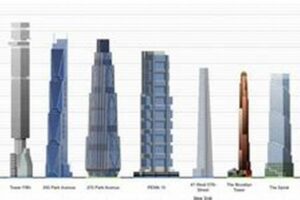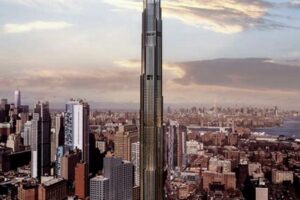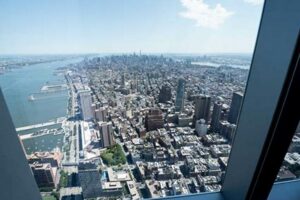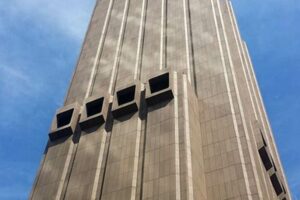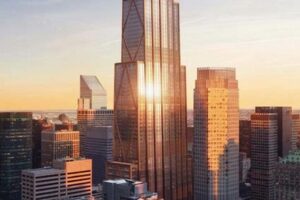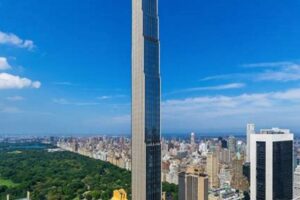The term “skinny skyscraper” is often used to describe a type of high-rise building that is characterized by its slender profile and narrow floor plates. These buildings are typically designed to maximize views and natural light, and they often feature innovative structural systems that allow for greater height and efficiency.
Skinny skyscrapers have become increasingly popular in New York City in recent years, as developers seek to create new and iconic landmarks. Some of the city’s most famous skinny skyscrapers include 432 Park Avenue, the Steinway Tower, and the Central Park Tower.
The rise of skinny skyscrapers in New York City has been driven by a number of factors, including the city’s high land prices, its strong demand for luxury housing, and its iconic skyline.Skinny skyscrapers offer a number of advantages over traditional high-rise buildings. They are more efficient to build, they can provide more natural light and views, and they can be more sustainable. However, they can also be more challenging to design and construct, and they can be more expensive to maintain.
1. Height
The height of skinny skyscrapers is a defining characteristic that sets them apart from other types of buildings. The extreme height of these buildings is made possible by a number of factors, including:
- Advanced structural engineering: Skinny skyscrapers use innovative structural systems that allow them to withstand high winds and seismic forces.
- Lightweight materials: Skinny skyscrapers are often constructed using lightweight materials, such as steel and glass, which reduce the overall weight of the building.
- Narrow floor plates: Skinny skyscrapers have narrow floor plates, which reduces the amount of wind resistance the building experiences.
The height of skinny skyscrapers offers a number of advantages, including:
- Stunning views: Skinny skyscrapers offer stunning views of the city, as they are often located in prime locations.
- Natural light: Skinny skyscrapers have large windows that allow for plenty of natural light to enter the building.
- Prestige: Living or working in a skinny skyscraper is often seen as a status symbol, as these buildings are associated with luxury and exclusivity.
However, the height of skinny skyscrapers can also pose some challenges, including:
- Wind resistance: Skinny skyscrapers are more susceptible to wind resistance than other types of buildings, which can lead to swaying and discomfort for occupants.
- Construction costs: Skinny skyscrapers are more expensive to build than other types of buildings, due to the need for specialized materials and construction techniques.
- Maintenance costs: Skinny skyscrapers can be more expensive to maintain than other types of buildings, due to the need for specialized equipment and access to the building’s exterior.
Overall, the height of skinny skyscrapers is a key defining characteristic that offers a number of advantages and challenges. These buildings are a testament to the ingenuity of architects and engineers, and they continue to push the boundaries of what is possible in high-rise construction.
2. Slender
The slenderness of skinny skyscrapers is a key defining characteristic that sets them apart from other types of buildings. The narrow profile of these buildings is achieved through a number of design and construction techniques, including:
- Lightweight materials: Skinny skyscrapers are often constructed using lightweight materials, such as steel and glass, which reduce the overall weight of the building.
- Narrow floor plates: Skinny skyscrapers have narrow floor plates, which reduces the amount of wind resistance the building experiences.
- Setbacks: Skinny skyscrapers often have setbacks, which are reductions in the building’s width at certain heights. Setbacks help to reduce wind resistance and create a more visually interesting building.
The slenderness of skinny skyscrapers offers a number of advantages, including:
- Reduced wind resistance: The narrow profile of skinny skyscrapers reduces the amount of wind resistance the building experiences, which makes them more stable and less likely to sway.
- Increased natural light: The narrow floor plates of skinny skyscrapers allow for more natural light to enter the building, which can reduce energy costs and create a more pleasant living or working environment.
- Reduced construction costs: The use of lightweight materials and narrow floor plates can reduce the construction costs of skinny skyscrapers, as less materials are required.
However, the slenderness of skinny skyscrapers can also pose some challenges, including:
- Lateral stability: The narrow profile of skinny skyscrapers can make them more susceptible to lateral forces, such as wind and earthquakes. To address this, skinny skyscrapers often use a variety of structural systems, such as outriggers and tuned mass dampers, to improve their lateral stability.
- Fire safety: The narrow floor plates of skinny skyscrapers can make it more difficult for occupants to evacuate in the event of a fire. To address this, skinny skyscrapers often have a variety of fire safety features, such as sprinklers, smoke detectors, and fire stairs.
Overall, the slenderness of skinny skyscrapers is a key defining characteristic that offers a number of advantages and challenges. These buildings are a testament to the ingenuity of architects and engineers, and they continue to push the boundaries of what is possible in high-rise construction.
3. Efficient
The efficiency of skinny skyscrapers is one of their key advantages, and it is a major factor in their growing popularity. There are a number of ways in which skinny skyscrapers are more efficient than traditional high-rise buildings, including:
- Less materials: Skinny skyscrapers require less materials to build than traditional high-rise buildings, as they have a smaller overall volume. This is because skinny skyscrapers have narrow floor plates and fewer exterior walls.
- Less energy: Skinny skyscrapers require less energy to heat and cool than traditional high-rise buildings, as they have a smaller surface area exposed to the outside air. This is because skinny skyscrapers have a narrow profile and fewer windows.
- Less maintenance: Skinny skyscrapers require less maintenance than traditional high-rise buildings, as they have fewer exterior surfaces to maintain. This is because skinny skyscrapers have a narrow profile and fewer windows.
The efficiency of skinny skyscrapers is a major benefit for both developers and tenants. Developers can save money on construction and maintenance costs, and tenants can save money on energy costs. In addition, skinny skyscrapers are more sustainable than traditional high-rise buildings, as they require less materials and energy to build and operate.
4. Views
The connection between stunning views and skinny skyscrapers in NYC is undeniable. These buildings are often located in prime locations, affording residents and visitors alike with breathtaking vistas of the city’s iconic skyline, sprawling parks, and vibrant neighborhoods.
- Unobstructed Views
Unlike traditional high-rise buildings with bulky massing and wide floor plates, skinny skyscrapers feature slender profiles and narrow footprints. This design allows for expansive windows that stretch from floor to ceiling, providing unobstructed views of the city from every angle.
- Height Advantage
Skinny skyscrapers are known for their impressive heights, often towering over 1,000 feet. This elevation grants residents and visitors unparalleled panoramic views that encompass the city’s landmarks, bridges, and waterways.
- Prime Locations
Developers of skinny skyscrapers carefully select prime locations within the city, often in close proximity to Central Park, the Hudson River, or other iconic destinations. These locations offer not only stunning views but also convenient access to the city’s cultural, recreational, and business hubs.
- Architectural Innovations
To maximize views, architects of skinny skyscrapers employ innovative design strategies. Floor-to-ceiling windows, glass balconies, and rooftop terraces are common features that blur the boundaries between indoor and outdoor spaces, allowing residents to fully immerse themselves in the cityscape.
In conclusion, the connection between stunning views and skinny skyscrapers in NYC is a defining characteristic of these architectural marvels. Their slender profiles, impressive heights, prime locations, and innovative designs combine to create a unique and unforgettable living experience, offering residents and visitors alike the opportunity to witness the city’s beauty from a truly breathtaking perspective.
5. Natural light
The abundance of natural light in skinny skyscrapers is a defining characteristic that sets them apart from other types of buildings. This is achieved through the use of large windows that span from floor to ceiling, allowing for maximum exposure to sunlight.
- Enhanced Well-being and Health
Exposure to natural light has been scientifically proven to have numerous benefits for human well-being and health. It can improve mood, increase productivity, and boost overall energy levels. The ample natural light in skinny skyscrapers creates a more comfortable and inviting living or working environment.
- Reduced Energy Consumption
The large windows in skinny skyscrapers not only provide natural light but also reduce the need for artificial lighting. This can lead to significant energy savings, especially in areas with long daylight hours. The use of natural light can also help to reduce the building’s carbon footprint.
- Aesthetic Appeal and Architectural Design
The large windows in skinny skyscrapers are not only functional but also contribute to the building’s overall aesthetic appeal. They create a sense of openness and transparency, and they can offer stunning views of the surrounding cityscape. Architects often use the windows as a design element, creating unique and visually striking facades.
- Increased Property Value
The presence of abundant natural light is a highly sought-after feature in residential and commercial buildings. As a result, skinny skyscrapers with large windows tend to have higher property values and are more attractive to potential buyers or tenants.
In conclusion, the connection between natural light and skinny skyscrapers in NYC is a significant one. The large windows in these buildings not only provide stunning views but also contribute to the well-being of occupants, reduce energy consumption, enhance the building’s aesthetic appeal, and increase its property value.
6. Sustainable
The connection between sustainability and skinny skyscrapers in NYC is a growing trend, as architects and developers recognize the importance of environmentally conscious design. Skinny skyscrapers, with their unique design and structural characteristics, offer a number of opportunities for sustainable features and practices.
One key aspect of sustainability in skinny skyscrapers is the incorporation of rainwater harvesting systems. These systems collect rainwater from the building’s roof and exterior surfaces, which can then be used for irrigation, flushing toilets, or other non-potable purposes. This helps to reduce the building’s reliance on municipal water supplies and promote water conservation.
Another important sustainable feature in skinny skyscrapers is the use of solar panels. Solar panels convert sunlight into electricity, which can be used to power the building’s common areas, lighting, and even individual units. This can significantly reduce the building’s energy consumption and carbon footprint.
In addition to these specific features, the overall design of skinny skyscrapers can also contribute to sustainability. The narrow floor plates and efficient use of space can reduce the building’s overall energy consumption. The use of high-performance glazing and insulation can also help to minimize heat loss and improve the building’s thermal performance.
The growing emphasis on sustainability in skinny skyscrapers is driven by a number of factors, including increasing environmental awareness, rising energy costs, and government regulations. As the demand for sustainable buildings continues to grow, skinny skyscrapers are well-positioned to meet this demand and offer a more environmentally friendly option for high-rise living and working.
7. Iconic
The connection between the iconic status of skinny skyscrapers in NYC and their overall significance cannot be overstated. These architectural marvels have become synonymous with the city’s skyline, captivating the attention of locals and tourists alike. Their presence in popular culture, particularly in movies and TV shows, further solidifies their iconic status and contributes to their broader appeal.
Several factors have contributed to the iconic status of skinny skyscrapers in NYC. Their unique and striking designs, often characterized by slender profiles and floor-to-ceiling windows, set them apart from traditional high-rise buildings. This distinctive aesthetic has made them instantly recognizable and highly photogenic, attracting the attention of filmmakers and photographers.
Moreover, the concentration of skinny skyscrapers in prominent locations within the city, such as Midtown Manhattan and the Financial District, has further elevated their iconic status. Their presence along iconic streets and in close proximity to renowned landmarks has made them an integral part of the city’s visual identity. As a result, they have become backdrops for countless cinematic scenes and establishing shots, reinforcing their association with the city’s image.
The iconic status of skinny skyscrapers in NYC has practical implications as well. Their presence in popular culture has contributed to the city’s overall appeal as a tourist destination. Visitors from around the world come to NYC specifically to witness these architectural wonders and capture their own images against their towering facades. This, in turn, generates economic benefits for the city through increased tourism and related industries.
In conclusion, the iconic status of skinny skyscrapers in NYC is deeply intertwined with their architectural significance and their presence in popular culture. These buildings have become symbols of the city’s modernity, ambition, and architectural prowess. Their presence in movies and TV shows has further cemented their iconic status and contributed to their broader appeal, both domestically and internationally.
Skinny Skyscrapers in NYC
Skinny skyscrapers have become a defining feature of the New York City skyline, captivating attention with their slender profiles and impressive heights. To shed light on these architectural marvels, we present answers to some of the most commonly asked questions surrounding skinny skyscrapers in NYC.
Question 1: What is a skinny skyscraper?
A skinny skyscraper is a high-rise building characterized by its exceptionally narrow width-to-height ratio. These buildings often have a width of less than 1:10 their height, resulting in a slender and visually striking appearance.
Question 2: Why are skinny skyscrapers so popular in NYC?
Skinny skyscrapers have gained popularity in NYC due to several factors, including the city’s limited land availability, high land prices, and zoning regulations that encourage the construction of tall and slender buildings.
Question 3: What are the advantages of living in a skinny skyscraper?
Living in a skinny skyscraper offers several advantages, such as stunning views, ample natural light, and a sense of exclusivity. Additionally, some skinny skyscrapers feature state-of-the-art amenities and eco-friendly designs.
Question 4: Are skinny skyscrapers safe?
Yes, skinny skyscrapers are designed to be safe and structurally sound. They employ advanced engineering techniques and high-quality materials to withstand strong winds and seismic activity.
Question 5: What is the tallest skinny skyscraper in NYC?
As of 2023, the tallest skinny skyscraper in NYC is Central Park Tower, standing at 1,550 feet tall with 98 stories.
Question 6: What is the future of skinny skyscrapers in NYC?
The future of skinny skyscrapers in NYC remains bright, with new projects continuously emerging. As the city continues to grow and evolve, skinny skyscrapers are likely to remain a prominent feature of the urban landscape.
In conclusion, skinny skyscrapers in NYC represent architectural innovation, engineering prowess, and a commitment to vertical living. They offer unique advantages and have become iconic landmarks that contribute to the city’s vibrant and ever-changing skyline.
Moving forward, we will explore the various aspects of skinny skyscrapers in NYC in greater detail, including their design, construction, and impact on the urban environment.
Tips for Understanding Skinny Skyscrapers in NYC
Skinny skyscrapers have become ubiquitous in the New York City skyline, capturing attention with their slender profiles and impressive heights. To fully appreciate and understand these architectural marvels, here are a few tips to keep in mind:
Tip 1: Understand the Concept of Aspect Ratio
The defining characteristic of skinny skyscrapers is their exceptionally narrow width-to-height ratio. This ratio is typically less than 1:10, resulting in a visually striking and slender appearance.
Tip 2: Consider the Engineering Challenges
Constructing skinny skyscrapers poses unique engineering challenges due to their height and narrowness. Advanced engineering techniques and high-quality materials are employed to ensure structural stability and withstand strong winds and seismic activity.
Tip 3: Explore the Advantages of Living in a Skinny Skyscraper
Living in a skinny skyscraper offers several advantages, including stunning views, ample natural light, and a sense of exclusivity. Additionally, some skinny skyscrapers feature state-of-the-art amenities and eco-friendly designs.
Tip 4: Appreciate the Architectural Innovation
Skinny skyscrapers represent architectural innovation and a commitment to vertical living. Their slender designs and use of glass and steel create a unique aesthetic that has become synonymous with modern urban architecture.
Tip 5: Visit Iconic Skinny Skyscrapers
To truly experience the grandeur of skinny skyscrapers, visit iconic structures like 432 Park Avenue, the Steinway Tower, and Central Park Tower. Observe their architectural details, take in the breathtaking views, and appreciate their contribution to the city’s skyline.
Summary
By understanding the concept of aspect ratio, considering the engineering challenges, exploring the advantages of living in skinny skyscrapers, appreciating their architectural innovation, and visiting iconic examples, you can gain a deeper understanding of these remarkable structures that have reshaped the New York City skyline.
Conclusion
The skinny skyscraper has emerged as a defining architectural feature of New York City, pushing the boundaries of engineering and design. These slender towers, characterized by their narrow width-to-height ratios, have transformed the city’s skyline, offering unique living experiences and captivating the attention of the world.
Throughout this exploration, we have examined the various aspects of skinny skyscrapers in NYC, from their structural innovations to their impact on the urban environment. Their efficient use of space, abundance of natural light, and sustainable features make them not only visually striking but also environmentally conscious.
As the demand for vertical living continues to grow, skinny skyscrapers are likely to remain a prominent fixture in the future of NYC’s architectural landscape. Their iconic status and contribution to the city’s identity will continue to inspire architects, engineers, and residents alike.


